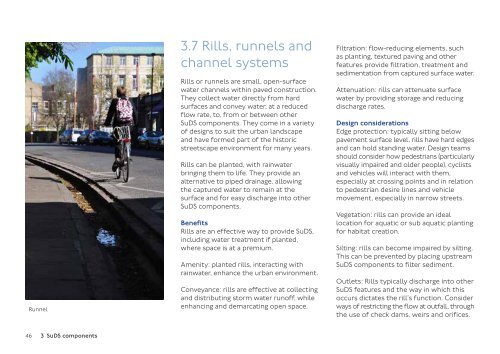SuDS in London - a guide
sustainable-urban-drainage-november-2016
sustainable-urban-drainage-november-2016
Create successful ePaper yourself
Turn your PDF publications into a flip-book with our unique Google optimized e-Paper software.
Runnel<br />
3.7 Rills, runnels and<br />
channel systems<br />
Rills or runnels are small, open-surface<br />
water channels with<strong>in</strong> paved construction.<br />
They collect water directly from hard<br />
surfaces and convey water, at a reduced<br />
flow rate, to, from or between other<br />
<strong>SuDS</strong> components. They come <strong>in</strong> a variety<br />
of designs to suit the urban landscape<br />
and have formed part of the historic<br />
streetscape environment for many years.<br />
Rills can be planted, with ra<strong>in</strong>water<br />
br<strong>in</strong>g<strong>in</strong>g them to life. They provide an<br />
alternative to piped dra<strong>in</strong>age, allow<strong>in</strong>g<br />
the captured water to rema<strong>in</strong> at the<br />
surface and for easy discharge <strong>in</strong>to other<br />
<strong>SuDS</strong> components.<br />
Benefits<br />
Rills are an effective way to provide <strong>SuDS</strong>,<br />
<strong>in</strong>clud<strong>in</strong>g water treatment if planted,<br />
where space is at a premium.<br />
Amenity: planted rills, <strong>in</strong>teract<strong>in</strong>g with<br />
ra<strong>in</strong>water, enhance the urban environment.<br />
Conveyance: rills are effective at collect<strong>in</strong>g<br />
and distribut<strong>in</strong>g storm water runoff, while<br />
enhanc<strong>in</strong>g and demarcat<strong>in</strong>g open space.<br />
Filtration: flow-reduc<strong>in</strong>g elements, such<br />
as plant<strong>in</strong>g, textured pav<strong>in</strong>g and other<br />
features provide filtration, treatment and<br />
sedimentation from captured surface water.<br />
Attenuation: rills can attenuate surface<br />
water by provid<strong>in</strong>g storage and reduc<strong>in</strong>g<br />
discharge rates.<br />
Design considerations<br />
Edge protection: typically sitt<strong>in</strong>g below<br />
pavement surface level, rills have hard edges<br />
and can hold stand<strong>in</strong>g water. Design teams<br />
should consider how pedestrians (particularly<br />
visually impaired and older people), cyclists<br />
and vehicles will <strong>in</strong>teract with them,<br />
especially at cross<strong>in</strong>g po<strong>in</strong>ts and <strong>in</strong> relation<br />
to pedestrian desire l<strong>in</strong>es and vehicle<br />
movement, especially <strong>in</strong> narrow streets.<br />
Vegetation: rills can provide an ideal<br />
location for aquatic or sub aquatic plant<strong>in</strong>g<br />
for habitat creation.<br />
Silt<strong>in</strong>g: rills can become impaired by silt<strong>in</strong>g.<br />
This can be prevented by plac<strong>in</strong>g upstream<br />
<strong>SuDS</strong> components to filter sediment.<br />
Outlets: Rills typically discharge <strong>in</strong>to other<br />
<strong>SuDS</strong> features and the way <strong>in</strong> which this<br />
occurs dictates the rill’s function. Consider<br />
ways of restrict<strong>in</strong>g the flow at outfall, through<br />
the use of check dams, weirs and orifices.<br />
46 3 <strong>SuDS</strong> components


